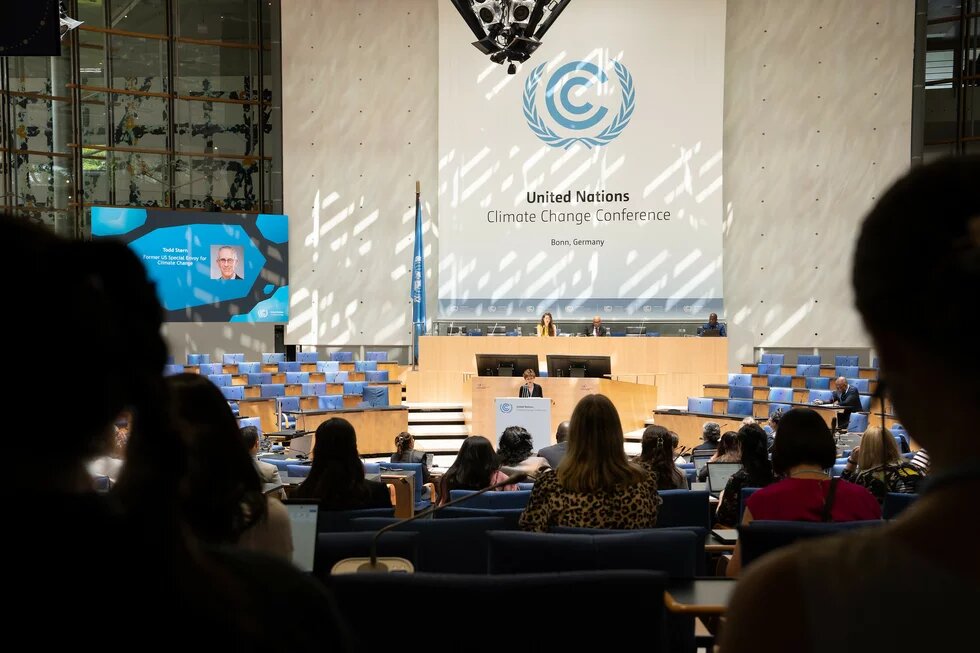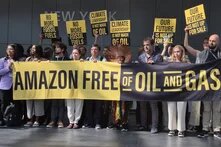The danger posed by global climate and environmental crises has been known for decades, but so far it has not been possible to address them effectively and fairly on a global scale. An overview of the most important international climate agreements, how they work, their potential and the challenges they face.

The UNFCCC (United Nations Framework Convention on Climate Change) is the most important negotiating framework for international climate policy. The agreement was adopted in 1992 and entered into force in 1994. At the same UN conference in Rio de Janeiro, the Convention on Biological Diversity (CBD) was also signed, laying the foundation for the later United Nations Convention to Combat Desertification (UNCCD) – and thus for a comprehensive international response to other global ecological crises that often receive less attention than the climate crisis, but are closely interlinked.
The UNFCCC currently has 197 signatory states. The most important decision-making body is the annual Conference of the Parties (COP), together with two technical subsidiary bodies, the Subsidiary Body for Scientific and Technological Advice (SBSTA) and the Subsidiary Body for Implementation (SBI), which meet every six months. The UNFCCC Secretariat, based in Bonn, provides organisational and technical support. The Kyoto Protocol and the Paris Agreement, both binding climate agreements under the UNFCCC, each have their own decision-making body, the CMP (Conference of the Parties serving as the meeting of the Parties to the Kyoto Protocol) and the CMA (Conference of the Parties serving as the meeting of the Parties to the Paris Agreement).
From Kyoto to Paris
The first internationally binding climate protection agreement under the UNFCCC was the Kyoto Protocol in 1997, which came into force in 2005 with 192 signatory states – but without the United States of America, historically the largest emitter of of greenhouse gas pollutants. Based on the principle of common but differentiated responsibilities and respective capabilities (CBDR-RC) of states for the climate crisis, on which the Climate Framework Convention is based, the Kyoto Protocol set binding emission reduction targets for the Global North (the so-called Annex I countries) over two commitment periods (Kyoto I, 2008-2012 and Kyoto II, 2013-2020). The outcome of the Kyoto Protocol is mixed at best: although it has led to a reduction in emissions in the participating industrialised countries, this has not been on the scale necessary to significantly mitigate the climate crisis. This is mainly because the United States did not ratify the Kyoto Protocol, and important emerging economies such as China, India and Brazil were not included, while other major emitters did not participate in Kyoto II. As the first multilateral climate agreement, the Kyoto Protocol was a step in the right direction, but its implementation and impact were completely inadequate.
In order to raise climate protection ambitions, the Paris Agreement was adopted in December 2015 and entered into force in November 2016. In it, the international community collectively committed to limiting global warming to 1.5°C if possible, but in any case to well below 2°C. Unlike the Kyoto Protocol, under the Paris Agreement all countries are obliged to contribute to achieving this goal – although the principle of common but differentiated responsibilities naturally continues to apply. Currently, 194 countries and the European Union have ratified the Paris Agreement. The withdrawal of the United States from the agreement, announced by the Trump administration in January 2025, will take effect in January 2026.
Key elements of the Paris Agreement
The primary mechanism for achieving the targets consists of national climate protection plans, known as nationally determined contributions (NDCs), which must be submitted regularly to the UNFCCC and whose emission reduction commitments are to be gradually increased (known as the ‘ratcheting-up mechanism’). Every five years, there is a global stocktake to review the status of the global progess to mitigate the climate crisis and, ideally, to increase efforts and commitments. The first Global Stocktake (GST) took place in 2023 and resulted in numerous new global commitments, such as the pledge to triple renewable energy globally by 2030 and to double energy efficiency over the same period. This came in light of the findings of the first GST, which showed that the international community is far from being able to collectively achieve the goals of the Paris Agreement. The COP28 decision text on the first GST in Dubai called on the signatories to the Paris Agreement for the first time to explicitly accelerate the phase-out of fossil fuels within this decade.
The fact that the efforts to reduce emissions under the Paris Agreement are determined at national level and are not binding at international level is a clear weakness of the agreement – the necessary emission reductions must be achieved collectively on a quasi ‘voluntary’ basis rather than on the basis of scientific necessity, such as the recommendations of the International Panel on Climate Change (IPCC). At the same time, it is only on a voluntary basis that the Paris Agreement was able to come about. In this context, it is interesting to note the opinion of the International Court of Justice (ICJ) on the question of what obligations states have under international law in dealing with the climate crisis, which was published in July 2025: It states that the existing body of applicable law, including human rights obligations and other environmental protection conventions, obliges all states to protect the climate, regardless of whether they have signed the Paris Agreement or not. At the same time, states are obliged to be as ambitious as possible in their individual national climate protection plans so that the goals of the Paris Agreement can be achieved collectively. Although the ICJ opinion is not binding law, it paves the way for individual states that fail to meet this obligation to be sued in national and international courts for liability and compensation.
International climate finance: industrialised countries must provide support
Climate finance is a central element of the Framework Convention on Climate Change and the Paris Agreement: both sets of rules emphasise the fundamental obligation of industrialised countries, in accordance with the principle of common but differentiated responsibilities and their historical responsibility for the climate crisis, to channel financial support to the Global South in its efforts to reduce emissions and adapt to climate change, as well as help with capacity-building measures and technology transfers. This is to be achieved through the direct provision of public funds and support in mobilising additional financial resources. These financial contributions are not a form of aid, but a legal obligation and should be provided in addition to development assistance.
An initial joint financing target at UNFCCC level of USD 100 billion per year, to be provided and mobilised by industrialised countries, was set in 2009, adopted by the Paris Agreement and was to be achieved by 2020 (but, at best — according to controversial calculations — was only be reached in 2022). It will be replaced from 2025 onward by a new collective financing target of USD 300 billion per year until 2035, which was agreed at COP29 in 2024 and effectively weakens the financing commitment of industrialised countries. At the same time, a much higher global mobilisation target of 1.3 trillion US dollars to support developing countries from 2035 onwards was agreed under this new collective quantified goal on climate finance (NCQG), although this relies primarily on private sector flows.
Adaptation to the climate crisis: systemic finance gap
In addition to reducing emissions, the Paris Agreement also set the global goal of increasing the resilience and adaptability of countries and communities to the impacts of the climate crisis and reducing their vulnerability. This is to be achieved, among other things, through regular reporting on adaptation measures and the development of national adaptation plans (NAPs) by the least developed countries with detailed protection and investment projects to be financed with support from industrialised countries (LDCs). A detailed list of indicators, which is currently being developed, is intended to create transparency and accountability for the achievement of the Global Goal on Adaptation (GGA). The systemic financing gap for adaptation efforts is one of the biggest obstacles to achieving this goal, as the largest share of climate finance flows supports emission reductions and the balanced financing for adaptation and mitigation that has been called for since 2009 still seems a long way off.
Loss and damage is no longer preventable
As the climate crisis progresses, so too does the loss and damage that can no longer be avoided despite efforts on emission reductions and adaptation to the climate crisis. The countries of the Global South, especially the small island developing states most severely affected, and international civil society have fought for decades in the UNFCCC and under the Paris Agreement (where loss and damage is recognised with its own article, but not formally included in its finance obligations). They finally achieved a breakthrough with the decision to establish a loss and damage fund at COP27 in Egypt, which was formally established the following year, although it remains critically underfunded.
International CO2 markets are fuelling the climate crisis
Under the Paris Agreement, as under Kyoto, there are mechanisms for trading CO2. Under Article 6, countries have the option of selling or purchasing CO2 certificates either bilaterally (under Article 6.2) or on a global market (under Article 6.4). On the seller side (e.g. of CO2 certificates for forest protection projects), this is intended to generate revenue, while on the buyer side, it appears cheaper to purchase climate protection from other parts of the world than to reduce emissions domestically. CO2 trading brings with it many problems, but from the perspective of climate impact, the following is particularly important: CO2 trading is, at best, a zero-sum game, as it aims to offset CO2 emissions at home with the help of certificates for CO2 reductions achieved elsewhere. In reality, however, carbon trading is not even a zero-sum game, as the compensation projects often do not lead to additional emissions reductions, while at the same time the fossil emissions that are to be offset continue to drive the climate crisis. In addition, compensation projects often result in human rights and land rights violations. There is also a worrying trend towards declaring cash flows in carbon trading as climate finance – even though this only finances hot air, with much of the money ending up with middlemen and failing to meet the industrialised countries' financial obligations to the Global South in terms of providing additional public funds.
Climate policy in the polycrisis
The climate crisis – as much as it is an existential global crisis – is repeatedly overshadowed by geopolitics and the multiple crises of the present. The enormous challenge of meeting the temperature limit set by the Paris Agreement through collective commitments remains immense and unfulfilled. Current climate policies and actions under existing NDCs would result in global warming of on average of 2.7°C (or within a 2.2°C to 3.4°C range). It is unlikely that this will change significantly under the new round of NDCs due by COP30 in Belém. With the renewed withdrawal of the United States – the country with the highest historical greenhouse gas emissions – from the Paris Agreement, the perhaps existential question arises as to how successful climate multilateralism can be in an era in which — in the face of multiple crises and political shifts in priorities towards defence spending and energy security — other industrialised countries are also questioning their commitments under the UNFCCC and the Paris Agreement: this concerns, for example, the leadership role in reducing emissions and providing the necessary financial support to the Global South. This was also evident recently in the negotiations on the new climate finance target.
The lack of adequate, comprehensive climate finance that meets the needs of the Global South in terms of adaptation to the climate crisis, addressing loss and damage, and efforts to reduce emissions continues to undermine trust and global climate protection ambitions. For example, many of the new climate protection commitments made by developing countries are conditional on adequate financial support for their implementation. At the same time, emerging economies such as China, Brazil and India and the wealthy Gulf states are not prepared to formally commit to more far-reaching multilateral obligations, in particular to provide financial support to the developing countries most affected by the climate crisis, which would call into question the basic principle of the UNFCCC of justice and common but differentiated responsibilities of industrialised and developing countries, also in view of historical emissions. However, the influence of these emerging economies in international climate diplomacy is growing due to the absence of the United States from the climate negotiations.
How can the relevance and effectiveness of a multilateral climate regime that is increasingly replacing binding commitments with voluntary measures be maintained, not least because international climate policy often plays only a minor role in many other international forums of global governance, such as the G7, the G20 or in the context of international financial and economic rule and decision-making? Pressure for comprehensive reforms in the UNFCCC is growing. Civil society demands for COP majority decisions instead of consensus decisions by all member states, as well as clear rules to prevent conflicts of interest that curb the influence of the fossil fuel industry and the private sector, and transparency and opportunities for civil society actors and particularly affected population groups to participate are important steps in this direction.

